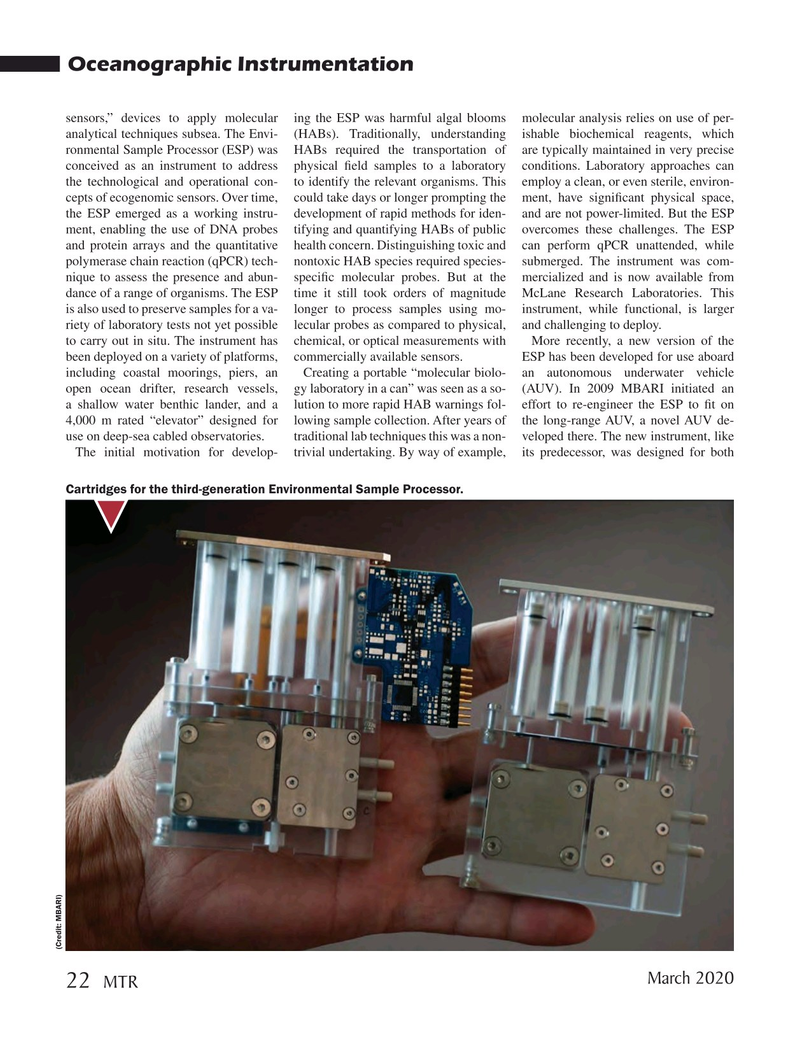
Page 22: of Marine Technology Magazine (March 2020)
Read this page in Pdf, Flash or Html5 edition of March 2020 Marine Technology Magazine
Oceanographic Instrumentation sensors,” devices to apply molecular ing the ESP was harmful algal blooms molecular analysis relies on use of per- analytical techniques subsea. The Envi- (HABs). Traditionally, understanding ishable biochemical reagents, which ronmental Sample Processor (ESP) was HABs required the transportation of are typically maintained in very precise conceived as an instrument to address physical ? eld samples to a laboratory conditions. Laboratory approaches can the technological and operational con- to identify the relevant organisms. This employ a clean, or even sterile, environ- cepts of ecogenomic sensors. Over time, could take days or longer prompting the ment, have signi? cant physical space, the ESP emerged as a working instru- development of rapid methods for iden- and are not power-limited. But the ESP ment, enabling the use of DNA probes tifying and quantifying HABs of public overcomes these challenges. The ESP and protein arrays and the quantitative health concern. Distinguishing toxic and can perform qPCR unattended, while polymerase chain reaction (qPCR) tech- nontoxic HAB species required species- submerged. The instrument was com- nique to assess the presence and abun- speci? c molecular probes. But at the mercialized and is now available from dance of a range of organisms. The ESP time it still took orders of magnitude McLane Research Laboratories. This is also used to preserve samples for a va- longer to process samples using mo- instrument, while functional, is larger riety of laboratory tests not yet possible lecular probes as compared to physical, and challenging to deploy.
to carry out in situ. The instrument has chemical, or optical measurements with More recently, a new version of the been deployed on a variety of platforms, commercially available sensors. ESP has been developed for use aboard including coastal moorings, piers, an Creating a portable “molecular biolo- an autonomous underwater vehicle open ocean drifter, research vessels, gy laboratory in a can” was seen as a so- (AUV). In 2009 MBARI initiated an a shallow water benthic lander, and a lution to more rapid HAB warnings fol- effort to re-engineer the ESP to ? t on 4,000 m rated “elevator” designed for lowing sample collection. After years of the long-range AUV, a novel AUV de- use on deep-sea cabled observatories. traditional lab techniques this was a non- veloped there. The new instrument, like
The initial motivation for develop- trivial undertaking. By way of example, its predecessor, was designed for both
Cartridges for the third-generation Environmental Sample Processor.
(Credit: MBARI)
March 2020 22 MTR
MTR #2 (18-33).indd 22 MTR #2 (18-33).indd 22 2/27/2020 9:21:03 AM2/27/2020 9:21:03 AM

 21
21

 23
23
